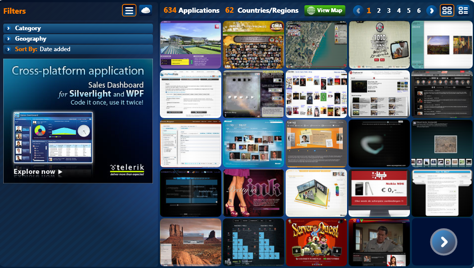 Although Microsoft’s Silverlight was originally conceived as a competitor to Adobe Flash, it now finds itself competing with Abobe’s web 2.0 platform, Adobe Air. The harsh truth is however, only 2 years on from its original release and Silverlight has already fallen woefully behind Adobe Air. In typical Microsoft style, the software giant surely missed the boat by aiming at a competitor for Adobe Flash when the web world was already looking towards interactive Web 2.0 platforms such as Adobe Air. It says a lot that the New York Times recently dumped Silverlight for Adobe Air to re-launch their Times Reader application.
Although Microsoft’s Silverlight was originally conceived as a competitor to Adobe Flash, it now finds itself competing with Abobe’s web 2.0 platform, Adobe Air. The harsh truth is however, only 2 years on from its original release and Silverlight has already fallen woefully behind Adobe Air. In typical Microsoft style, the software giant surely missed the boat by aiming at a competitor for Adobe Flash when the web world was already looking towards interactive Web 2.0 platforms such as Adobe Air. It says a lot that the New York Times recently dumped Silverlight for Adobe Air to re-launch their Times Reader application.
Silverlight 3.0 has recently been released as an attempt to bridge the ever increasing chasm although it’s developers rather than end-users who will notice the most new innovations.
Silverlight is a lightweight plugin that allows you to watch video content in your browser in much the same way as Adobe Flash does on sites like YouTube. It works with most major browsers including Firefox, Safari and Chrome and plays WMV, WMA and MP3 content. Although there is no prompt to restart the browser after installation, I recommend you do so as the first Silverlight content I accessed after installation simply crashed Firefox.
For end users, the most important improvements to the latest version are smoother streaming, DRM management, and an external content player. The pop-out player however is dependent on developers embracing it and as yet, there are few examples available. The smooth streaming feature will iron out many of the streaming programs that have plagued Silverlight in the past. If your bandwidth drops below 3Mbps, smooth streaming will kick-in so that your video isn’t affected.

Silverlight 3 finally supports AAC audio decoding as well as hardware-accelerated H.264 video decoding which were big omissions in the previous release. Microsoft have also finally decided to open up the “native multimedia pipeline” so that other formats can be supported if the codecs are installed. Microsoft Silverlight 3.0 still maintains the ability to stream high resolution video and supports HD quality videos.

If you want to create content for Silverlight, you’ll need Expression Studio and Visual Studio. In fact, this latest release is is of particular interest to developers because it adds 60 customizable controls, new layout containers, “deep linking” for page bookmarking, search engine optimization and enhanced data support. Animators are also now far better supported with “Perspective 3D” which enables transformation of 2D elements to 3D.
The signs are however that Microsoft has already realized that the battle for web content is already being won by the much slicker and stable Adobe Air platform and is therefore aiming Silverlight at business users. The Silverlight homepage boasts “Learn how Silverlight is right for your business” and companies such as Continental Airlines have adopted it for use in their reservation system indicating that Microsoft knows which side its bread is buttered on.
Silverlight 3.0 is no Adobe Flash and certainly no Adobe Air. However, there’s probably no way you can avoid needing it at some point because there will always be some websites and developers that choose to base their content on Silverlight. Mobile devices are expected to be supported by 2010 although yet again, it may be a case of too little, too late for Microsoft.

